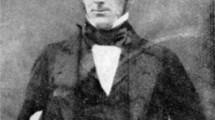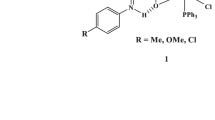Abstract
Toluene radical anion, generated by dissolving potassium metal in toluene by the assistance of dicyclohexano-18-crown-6, has been proved to be especially effective for reductive removal of fluorine atom from unactivated alkyl fluorides that resist common reduction conditions. Stereochemical and mechanistic aspects of the present method is discussed. In connection with the preparation of substrates the effect of dipolar aprotic solvents on the nucleophilic fluorination with potassium fluoride/dicyclohexano-18-crown-6 system was also examined, and sulfolane or N,N-dimethyl formamide was shown to be a solvent of choice.
Similar content being viewed by others
References and notes
T. Ohsawa, T. Takagaki, F. Ikehara, Y. Takahashi and T. Oishi,Chem. Pharm. Bull.,30, 3178 (1982).
C. J. Pedersen,J. Am. Chem. Soc.,89, 7017 (1967); C. J. Pedersen and H. K. Frensdorff,Angew. Chem. Int. Ed. Engl.,11, 16 (1972).
J.L. Dye, M.G. DeBacker and V.A. Nicely,J. Am. Chem. Soc.,92, 5226 (1970); J.L. Dye, M.T. Lock, F.J. Tehan, R.B. Coolen, N. Papadakis, J.M. Ceraso and M.G. DeBacker,Berichte Bunzenges Phys. Chem.,75, 659 (1971)
J.L. Dye, J.M. Ceraso, M.T. Lock, B.L. Barnett and F.J. Tehan,J. Am. Chem. Soc.,96, 608 (1974); F.J. Tehan, B.L. Barnett and J.L. Dye,ibid. 96, 7203 (1974).
J.L. Dye,Angew. Chem. Int. Ed. Engl. 18, 587 (1979); J.M. Lehn,Pure Appl. Chem. 52, 2303 (1980).
U. Schindewolf,Angew. Chem. Int. Ed. Eng l.,7, 190; D.M. Holton, P.P. Edwards, D.C. Johnson, C.J. Page, W. MacFarlane and B. Wood,J. C. S. Chem. Comm.,1984, 741.
A.G.M. Barrett, P.A. Prokopiou and D.H.R. Barton,J. C. S. Perkin Trans. I,1981, 1510. and references cited therein.
H.O. House,Modern Synthetic Reactions, 2nd ed., W.A. Benjamin, Inc., Menlo Park, 1972, pp. 145–227.
N.D. Scott, J.F. Walker and V.L. Hansley,J. Am. Chem. Soc.,58, 2442 (1936).
B. Kaempf, S. Raynal, A. Collet, F. Schue, S. Boileau and J.-M. Lehn,Angew. Chem. Int. Ed. Engl.,13, 611 (1974); M. Komarynsky and S.I. Weissman,J. Am. Chem. Soc.,97, 1589 (1975); G.V. Nelson and A.V. Zelewsky,ibid.,97, 6279 (1975); P. Belser, G. Desbiolles, U. Ochsenbein and A.V. Zelewsky,Helv. Chim. Acta.,63, 523 (1980).
K− solution is black-blue and toluene radical anion solution is brown-red in color.
Bond energy (Kcal/mol) C−H, 99; C−F, 116; C−Cl, 81; C−Br, 68; C−I, 51. J.B. Hendrickson, D.J. Cram and G.S. Hammond, “Organic Chemistry, 3rd ed.”, McGraw-Hill Kogakusha, Tokyo, 1970, pp 63.
J. Jacobus and J.F. Eastham,J. C. S. Chem. Comm.,1969, 138.
T. Ishihara, E. Ohtani and T. Ando,J. C. S. Chem. Comm.,1975, 367.
R.O. Hutchins, D. Kandasamy, C.A. Maryanoff, D. Masilamani and B.E. Maryanoff,J. Org. Chem.,42, 82 (1977).
M.A. Anbar and E.J. Hart,J. Phys. Chem.,69, 271 (1965).
D. Bryce-Smith, B.J. Wakefield and E.T. Blues,Proceeding Chem. Soc.,1963, 219
J.F. Garst and F.E. Barton II,Tetrahedron Lett.,1969, 587;J. Am. Chem. Soc.,96, 523 (1974); J.F. Garst, R.D. Roberts and B.N. Abels,J. Am. Chem. Soc.,97, 4925 (1975).
J.R. Lacher, A. Kianpour and J.D. Park,J. Phys. Chem.,60, 1454 (1956).
H. Kawasaki, N. Tone and K. Tonomura,Agri. Biol. Chem.,45, 29, 35, 543 (1981).
C.L. Liotta and H.P. Harris,J. Am. Chem. Soc.,96, 2250 (1974).
P. Ykman and H.K. Hall Jr.Tetrahedron Lett.,1975, 2429.
D. Landini and F. Montanari,J. C. S. Chem. Comm.,1974, 879.
Half-height width is much narrower at 50 C than at 20 C.
18-C-6 or dibenzo-18-C-6 gave poorer results.
N.E. Boutin, D.U. Robert and A.R. Cambon,Bull. Soc. Chim. Fr.,1974, 2861; Y. Kobayashi, I. Kumadaki, A. Ohsawa, M. Honda and Y. Hanzawa,Chem. Pharm. Bull.,23, 196 (1975); H.B. Henbest and W.R. Jackson,J. Chem. Soc.,1962, 954; S. Colonna, A. Re, G. Gelbard and E. Cesarotti,J. C. S. Perkin I,1979, 2248.
J. Diekman and C. Djerassi,J. Org. Chem.,32, 1005 (1967); O.H. Wheeler and J.L. Mateos,Can. J. Chem.,36, 1431 (1958).
O. Diels and P. Blumberg,Chem. Ber.,44, 2847 (1911); J. Mauthner,Monatsh Chem.,30, 635 (1909).
Synthesis of (10) was carried out from 24,24-dimethyl-24-hydroxycholane (11) with 70% hydrogen fluoride/pyridine (Aldrich) at ambient temperature in 64% yield. See G.A. Olah, J.T. Welch, Y.D. Vankar, M. Nojima, I. Kerekes and J.A. Olah,J. Org. Chem.,44, 3872 (1979).
M.R.C. Gestenberger and A.H. Haas,Angew. Chem. Int. Ed. Engl.,20, 638 (1981); M. Schlosser,Tetrahedron,34, 3 (1978); Ed. by Chem. Soc. Jpn.,Kagaku-Sosetsu,27, “Atarashii Fusso-Kagaku”, Gakkai Shuppan Centre, Tokyo, 1980.
Although these solvents have high dielectric constants, they are especially characterized by their low donor numbers which are the indexes of basicity.
A.F. Sowinsky and G.M. Whitesides,J. Org. Chem.,44, 2369 (1979).
Formation of complex in MeOH in advance, followed by solvent exchange, gave better result than direct reaction in sulfolane.
6-Fluoro-l-hexene was reduced under the same conditions to give l-hexene and methylcyclopentane in combined yield of 54–58%, based on alkyl fluoride consumed. See ref. J.F. Garst and F.E. Barton II,Tetrahedron Lett.,1969, 587;J. Am. Chem. Soc.,96, 523 (1974); J.F. Garst, R.D. Roberts and B.N. Abels,J. Am. Chem. Soc.,97, 4925 (1975).
L. F. Fieser and M. Fieser,Reagent for Organic synthesis, vol. l, John Wiley and Sons, Inc., New York, 1967, pp. 1102–1103.
T. Cuvigny and M. Larcheveque,J. Organomet. Chem.,64, 315 (1974).
Terminal vinyl group is easily saturated under K/DC-18-C-6/diglymeiPrOH conditions.
A.L.J. Beckwith and G. Moad,J. C. S. Chem. Comm.,1974, 472; C. Walling and A. Cioffari,J. Am. Chem. Soc.,94, 6059 (1972). See also ref 25).
J.R. Hanson, H.J. Wadsworth and W.E. Hull,J. C. S. Perkin I,1980, 1382.
P.E. Verkade, K.S. de Vries and B.M. Wepster,Rec. Trav. Chem. Pays-Bas,83, 367 (1964).
E.J. Corey, M.G. Howell, A. Boston, R.L. Young and R.A. Sneen,J. Am. Chem. Soc.,78, 5036 (1956).
Deuterium incorporation study using d8-toluene as solvent or D2O for quenching disclosed that D2O was not incorporated but deuterium in d8-toluene was incorporated to a certain extent. The detail will be reported elsewhere. See also ref. T. Ohsawa, T. Takagaki, A. Haneda and T. Oishi,Tetrahedron Lett.,1981, 2583.
Author information
Authors and Affiliations
Additional information
T. Ohsawa, T. Takagaki, A. Haneda and T. Oishi,Tetrahedron Lett.,1981, 2583.
Rights and permissions
About this article
Cite this article
Ohsawa, T., Oishi, T. Dissolving metal reduction K metal-crown ether-toluene system for reductive defluorination. Journal of Inclusion Phenomena 2, 185–194 (1984). https://doi.org/10.1007/BF00663255
Issue Date:
DOI: https://doi.org/10.1007/BF00663255




